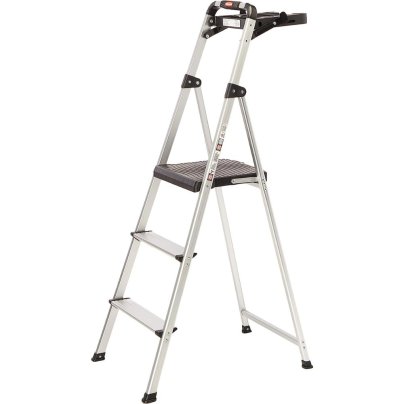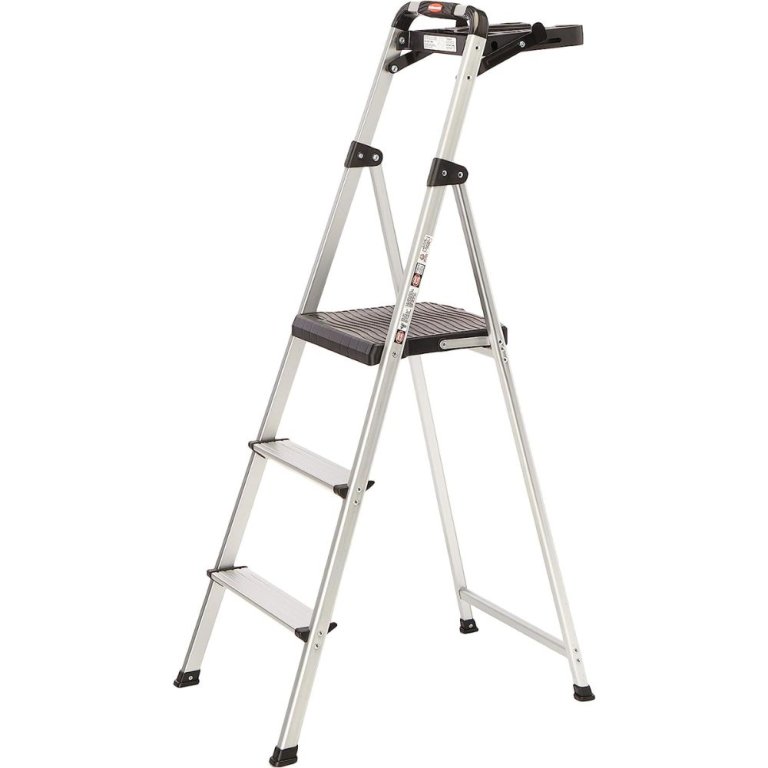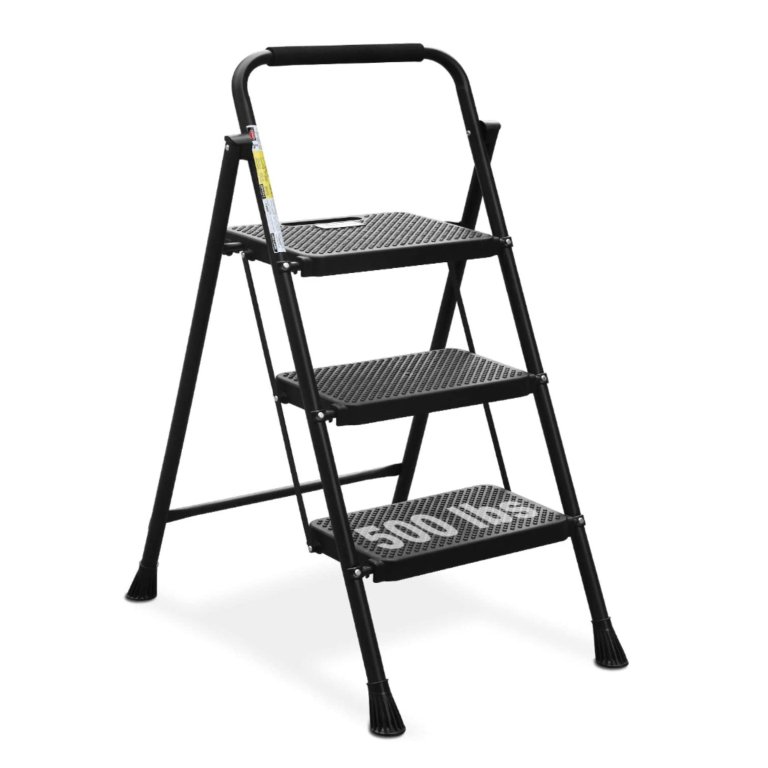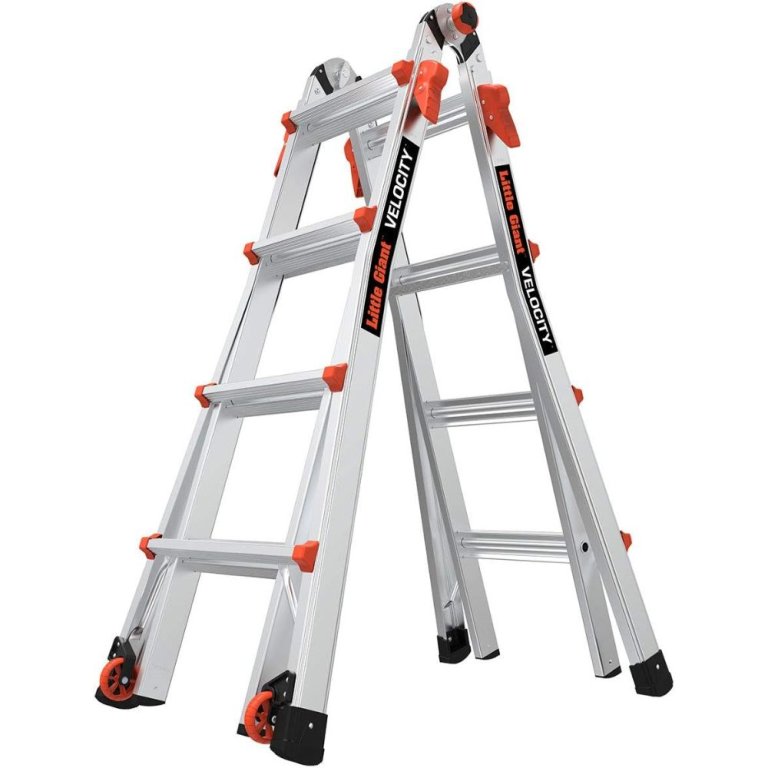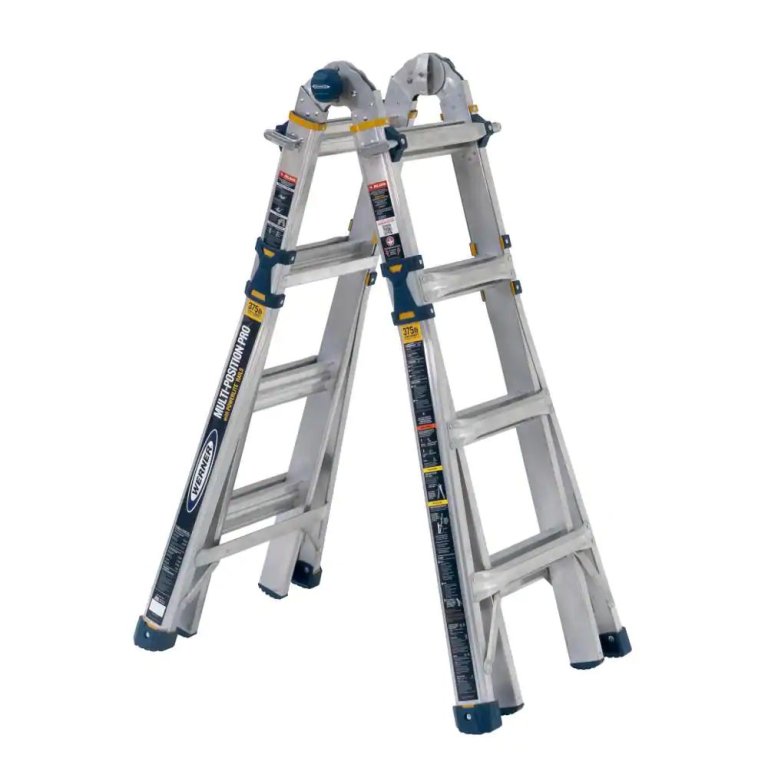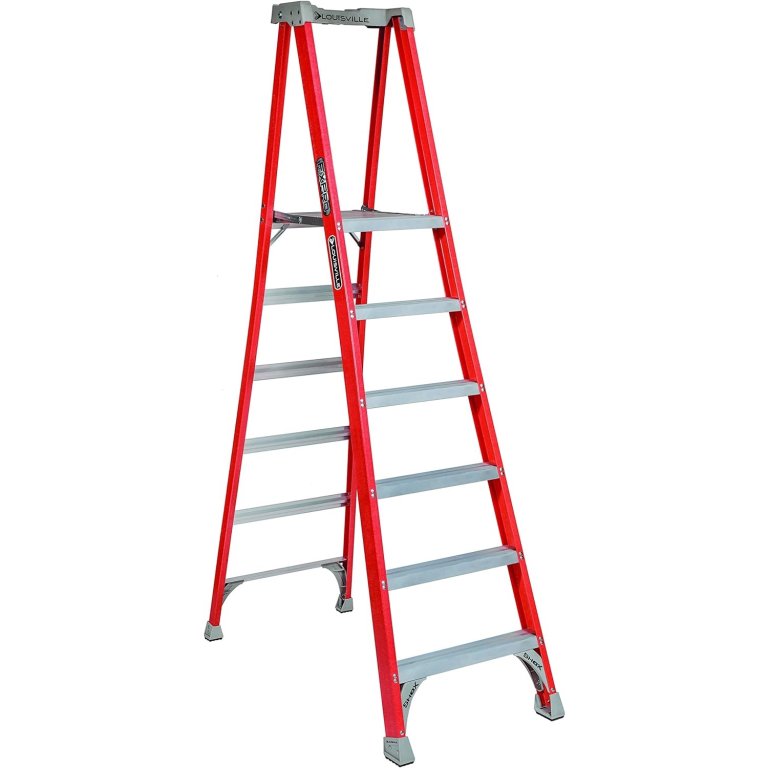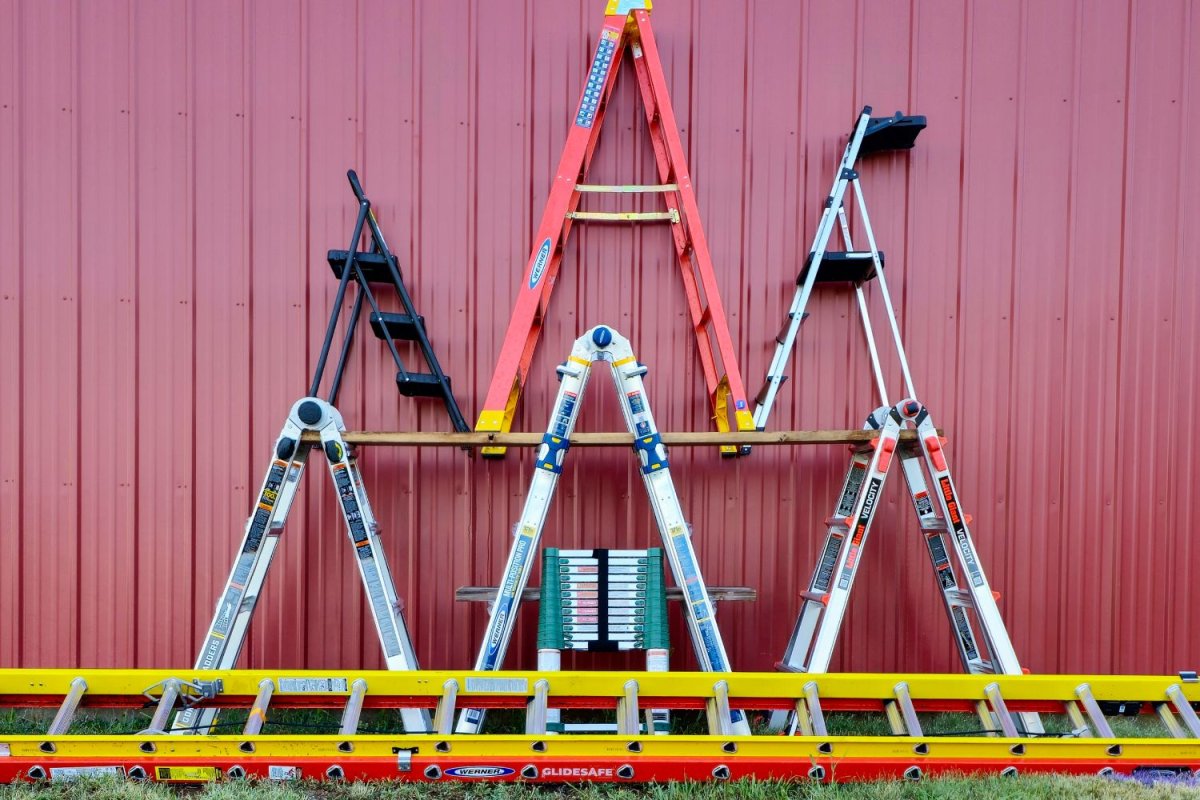
We may earn revenue from the products available on this page and participate in affiliate programs. Learn More ›
Every household needs a ladder from time to time. Light bulbs need to be replaced, artwork needs to be hung, windows need to be cleaned, and there’s always an exterior home maintenance project to tackle. Ladders come in a surprising array of types and sizes, including step ladders, extension ladders, and multi-position ladders, just to name a few. Each type is designed for a certain range of uses, so choosing the right one for your needs can be tricky. To cut through the confusion and help readers avoid unnecessary safety risks, we tested 10 different ladders, covering the range of types and materials that are available.
Our favorite of the test group is the Gorilla 22-foot multi-position ladder. It offers the versatility and reach to safely take on a wide range of indoor and outdoor projects, and it’s easy to store in a modest-size space. But any of the others could be the right choice for more specific user needs. In this guide, we’ll cover ladder shopping basics, including ladder types and uses, the pros and cons of aluminum versus fiberglass construction, and the safety features you’ll want to consider. Just ahead, we’ll share our observations from testing each of the following models and why we consider them to be some of the best ladders around.
- BEST OVERALL: Gorilla 22-Foot MPXA 2.0 Multi-Position Ladder
- BEST BANG FOR THE BUCK: Rubbermaid 3-Step Aluminum Stool With Project Tray
- BEST TELESCOPING LADDER: Xtend + Climb Pro Series 780P+ Telescoping Ladder
- BEST EXTENSION LADDER: Werner 28-Foot Fiberglass Glidesafe Extension Ladder
- BEST STEP STOOL: HBTower 3-Step Portable Steel Step Ladder
- BEST MULTIUSE LADDER: Little Giant Ladder Systems Velocity Multiuse Ladder
- BEST FOR HIGH CEILINGS: Werner 6-Foot Fiberglass Single-Sided Step Ladder
- BEST HEAVY-DUTY: Werner 18-Foot Multi-Position Ladder
- BEST PLATFORM LADDER: Louisville Ladder 6-Foot Fiberglass Platform Ladder
- BEST STEP LADDER: Louisville Ladder 10-Foot Aluminum Step Ladder
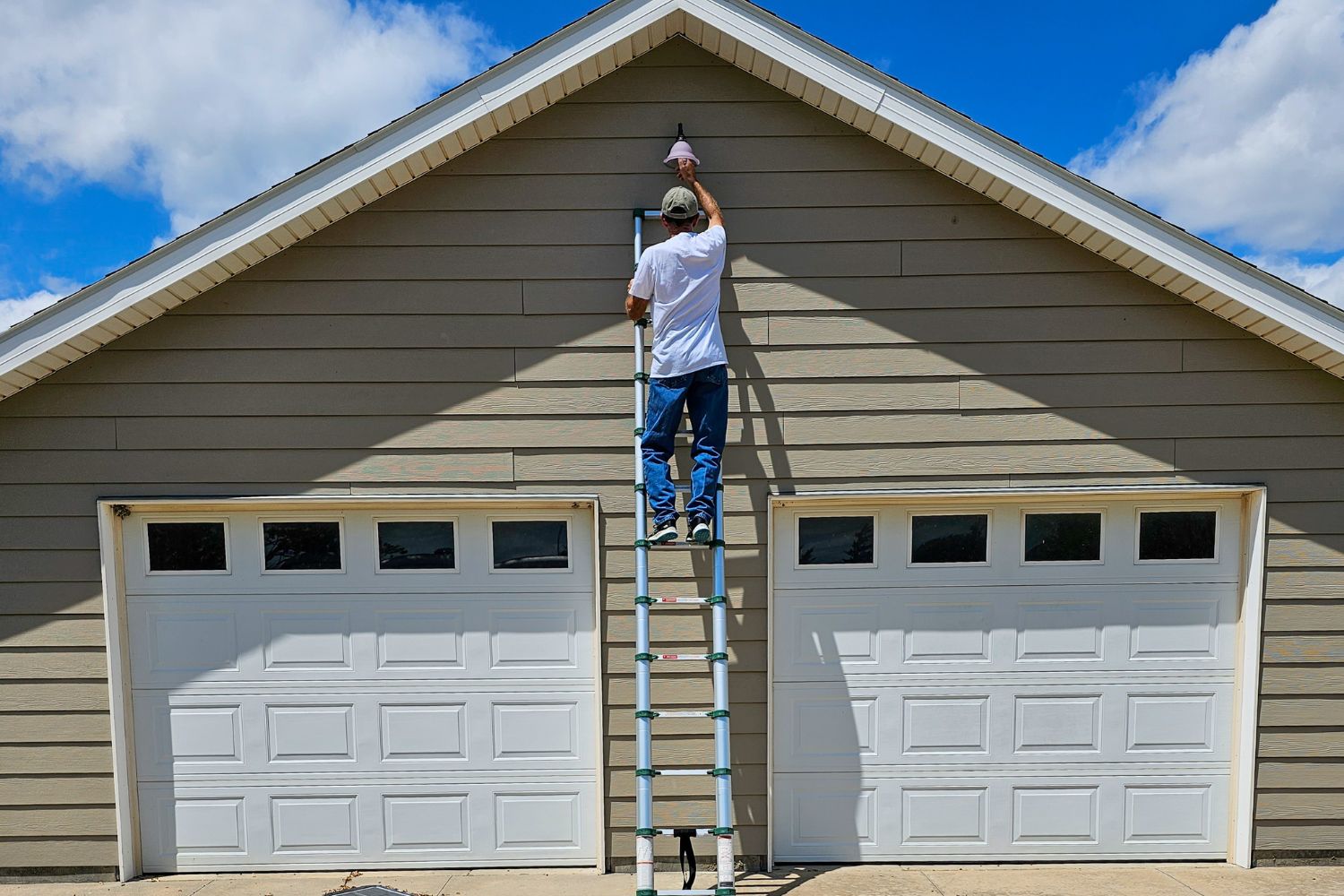
| Testing Stats | |
| Products tested | 10 |
| Time spent testing | 15 hours |
| Tests performed | 4 |
| Price range | $50 to $480 |
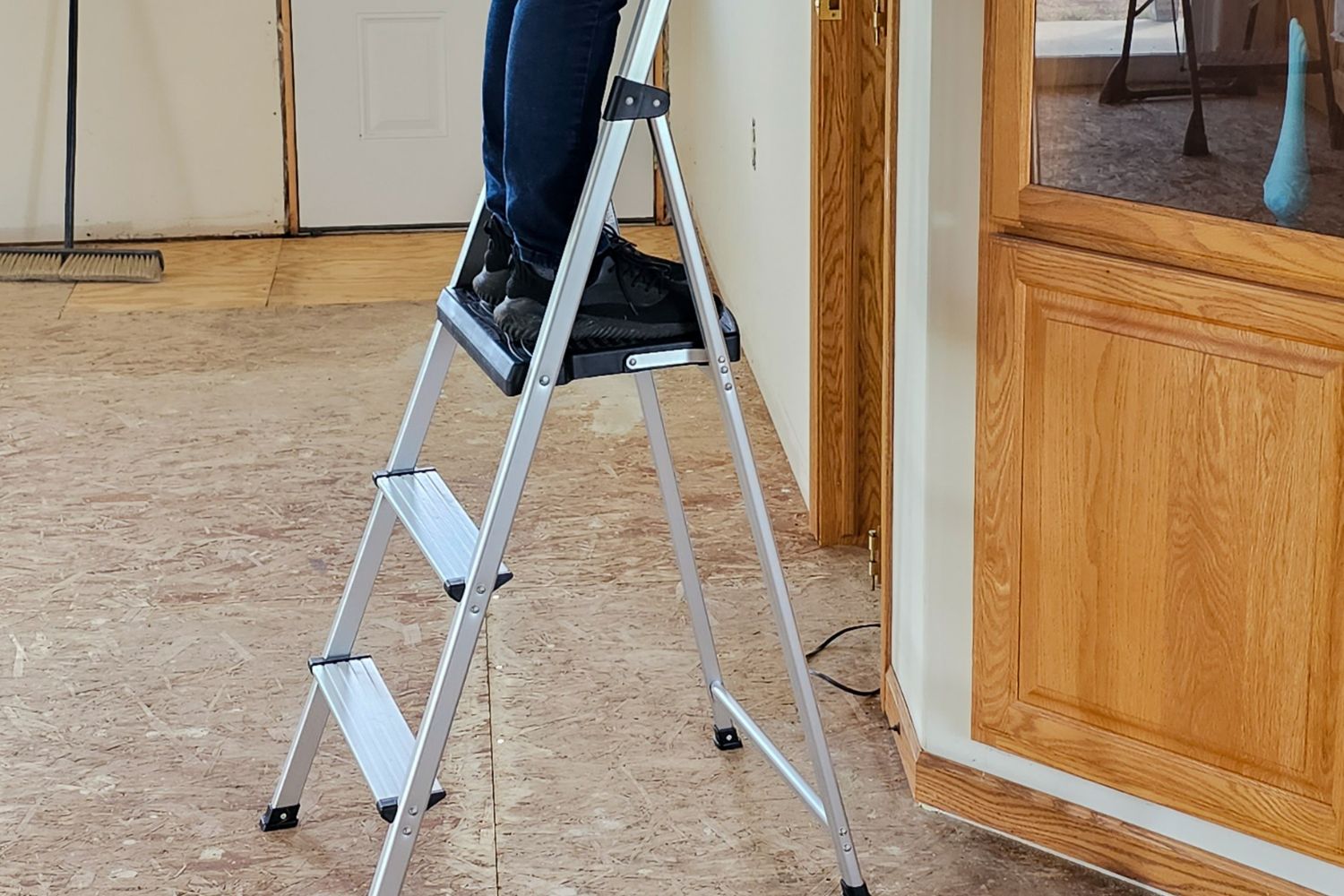
Our Top Picks
The following ladder recommendations are based on the results of our hands-on testing. While the costs and types of ladders vary, each one earned its spot in our lineup. One is sure to be a good choice for your climbing needs.
Best Overall
Gorilla 22-Foot MPXA 2.0 Multi-Position Ladder
What We Like
- Safely supports up to 300 pounds
- Features 5 multipurpose configurations
- Oversize hinges, grip locks, and nonslip feet for stability
What We Don’t Like
- Adjusting configurations is tricky at first
- Pricier compared to single-purpose ladders
Product Specs
- Type: Multi-position
- Maximum reach height: 22 feet
- Weight: 36.9 pounds
- Materials: Aluminum
- Load capacity: 300 pounds
This Bob Vila Approved product carries our brand’s highest level of recommendation.

Bob Vila Approved recognizes the household and DIY products that impressed us most in our real-world testing and that exemplify core values of the Bob Vila brand, including craftsmanship, innovation, and value for the dollar. Winners of this designation come recommended by our professional review team and are personally approved by Bob Vila.
Our Ratings: Build Quality 5/5; Stability 5/5; Portability 4/5; Value 4.7/5
The Gorilla multi-position ladder earned the top spot in our lineup with its impressive 300-pound load capacity and adjustable structure. It transforms into different configurations, including an extension ladder, step ladder, wall ladder, stairway step ladder, and even a scaffold base. This adaptability eliminates the need for multiple ladders, and we found it sturdy in all configurations.
It has oversize hinges, grip locks, and nonslip feet that help create a secure and wobble-free experience. We liked how stable the ladder was when extended to its full height. We’ve climbed on many tall ladders that had a tendency to flex, but this Gorilla model remained rigid and didn’t bounce. For a tall ladder, it’s relatively lightweight at 36.9 pounds, making it easy to carry and transport. It fits neatly into confined spaces, measuring 67 inches tall by 26 inches wide by 8.5 inches deep when folded. Despite being lightweight, it’s not rickety.
Those new to the concept of a multi-position ladder might initially struggle with the Gorilla’s various configurations and mechanisms—it took us a while to figure out how to adjust the ladder. Still, once we learned the process, it became second nature, and we could quickly change from one configuration to another.
The ladder’s heavy-duty feet offer exceptional grip on various surfaces, and the 1-inch rung depth enhances standing comfort during prolonged use.
Read our full review: Gorilla 22-Foot MPXA Multi-Position Aluminum Ladder
Get the Gorilla ladder exclusively at The Home Depot.
Best Bang for the Buck
Rubbermaid 3-Step Aluminum Stool With Project Tray
What We Like
- Lightweight design and sturdy construction
- Secure standing platform with locking mechanism
- Includes project tray to hold supplies
- Space-saving foldable design
What We Don’t Like
- Reach is limited to just under 9 feet
Product Specs
- Type: Step ladder/step stool
- Maximum reach height: 8 feet 10 inches
- Weight: 8 pounds
- Materials: Aluminum
- Load capacity: 225 pounds
Our Ratings: Build Quality 4.5/5; Stability 4.8/5; Portability 5/5; Value 5/5
For simple tasks that require just a little extra height, the Rubbermaid three-step aluminum stool with project tray is a quality choice at an attractive price point. This step ladder combines convenience, portability, and stability.
The first thing we noticed about this step ladder was the balance between weight and durability. Weighing in at a mere 8 pounds, the ladder was easy to carry. But don’t let its light weight fool you—it boasts robust construction that can support up to 225 pounds.
One of the standout features of the Rubbermaid stool is a spacious project tray that provides a hands-free storage solution for a paint bucket or tools. We also liked the nonslip hand grip along the top rail.
It comes with a stable standing platform that accommodates both feet and offers a bit of room for turning to one side or the other. It has an aluminum frame and rubber-padded feet that didn’t slide or shift during testing. Plus, it has an automatic locking mechanism that holds the standing platform firmly in place for added stability.The step ladder’s space-saving design makes it one of the best small ladders for those with limited storage space. It folds to a compact 56 inches tall by 19.7 inches wide by 3.5 inches deep when not in use, allowing users to stow it away neatly in a closet, garage, or utility room without taking up valuable space. Those looking for a budget-friendly step ladder for household tasks won’t be disappointed with this Rubbermaid model.
Get the Rubbermaid ladder at Amazon, The Home Depot, or Walmart.
Best Telescoping Ladder
Xtend + Climb Pro Series 780P+ Telescoping Ladder
What We Like
- Reaches up to 16 feet 6 inches
- Small footprint of just 32 inches when retracted
- Includes nonslip feet and one-rung-at-a-time retraction
What We Don’t Like
- Legs do not flair out for added stability
Product Specs
- Type: Telescoping
- Maximum reach height: 16 feet 6 inches
- Weight: 30 pounds
- Materials: Aluminum alloy
- Load capacity: 300 pounds
Our Ratings: Build Quality 4.5/5; Stability 4.5/5; Portability 5/5; Value 4.7/5
For those looking for a sturdy telescoping ladder, the Xtend + Climb Pro 780P+ telescoping ladder is an exceptional choice. Telescoping ladders are all the rage, but in our experience, many models just don’t make the cut in terms of safety. However, the Xtend + Climb does.
The 780P+ ladder extends to an impressive height of 12.5 feet and offers a reach height of up to 16.5 feet. What sets the 780+P apart from standard extension ladders is its portability. The ladder collapses to just 32 inches, making storage and transportation a snap.
This compact ladder isn’t limited to seasoned professionals; it’s also a perfect companion for dedicated DIY enthusiasts who value heavy-duty tools that deliver superior performance. Despite its lightweight design (30 pounds), the 780P+ is built to withstand tough challenges. We noticed only slight flexing when the ladder was fully extended, but it was still very stable. Plus, it features nonslip feet that stayed put as we climbed up and down.
The Xtend + Climb retracts one rung at a time, which is necessary for safety. Simultaneously pressing the thumb levers at both sides of each rung collapses the rung above. While some users might find this tedious, it’s much better than smashing a finger in a ladder that retracts all at once.
Get the Xtend + Climb ladder at The Home Depot, Amazon, or Acme Tools.
Best Extension Ladder
Werner 28-Foot Fiberglass Glidesafe Extension Ladder
What We Like
- Lift Assist technology reduces user strain
- Built-in lowering assist controls descent
- Dual-locking system prevents unintended ladder extension
- Features nonconductive fiberglass rails for working near electricity
What We Don’t Like
- Heavy at 59.5 pounds
Product Specs
- Type: Extension
- Maximum reach height: 27 feet 8 inches
- Weight: 59.5 pounds
- Materials: Fiberglass
- Load capacity: 300 pounds
Our Ratings: Build Quality 5/5; Stability 5/5; Portability 4/5; Value 4.7/5
We’ve used a lot of extension ladders over the years, and one of the biggest issues is the amount of physical strength it takes to extend the upper portion of the ladder. Werner has changed all that with its Lift Assist technology.
With Lift Assist, extending the ladder is up to 50 percent easier, sparing the user’s back and arms from unnecessary strain. The ladder uses spring-assisted components—much like a garage door opener—to reduce the force needed to raise the ladder. All we had to do was pull downward on the included rope, and the extension part of the ladder slid easily upward, locking in place rung by rung for safety.
Werner also includes a built-in lowering assist, which provides a controlled and gentle descent. Say goodbye to jarring slams, broken fingers, and rope burns; the GlideSafe technology of the Werner fiberglass extension ladder makes safety a priority. We also liked the ladder’s dual locking system that prevents ladder extension during transport.
Another perk is the fiberglass construction of this ladder—a must for electricians or anyone working around electricity because fiberglass is nonconductive. A slight downside is the ladder’s weight (59.5 pounds), which may be challenging for some users to carry. Still, the upsides of this extension ladder, including GlideSafe technology and nonconductive build, will be more important to many users.
Get the Werner extension ladder at Lowe’s, Ace Hardware, The Home Depot or Acme Tools.
Best Step Stool
HBTower 3-Step Portable Steel Step Ladder
What We Like
- Sized for practicality and portability
- Steel frame and safety lock for secure use
- Features rubber hand grip, nonslip pedals, and rubber feet
What We Don’t Like
- May take force to lock the platform into place
Product Specs
- Type: Step ladder
- Maximum reach height: Approximately 7 feet 5 inches
- Weight: 11.5 pounds
- Materials: Iron, polypropylene
- Load capacity: 500 pounds
Our Ratings: Build Quality 4.5/5; Stability 5/5; Portability 5/5; Value 4.7/5
The HBTower three-step is a lightweight folding ladder that redefines what a short ladder can offer. Opened, the HBTower measures 40.9 inches tall by 20.1 inches wide by 26.8 inches deep, while its folded dimensions of 44.5 inches tall by 20.1 inches wide by 1.6 inches deep make it convenient to carry and stow. It weighs just 11.5 pounds but comes with a substantial load capacity of up to 500 pounds, making it suitable for many users.
When open, the step ladder locks in place, but we found it took some force to engage the safety lock, which would not lock until we stepped on the top platform. It also took a solid tug to release the lock and fold the step ladder after use.
The HBTower features two oversize steps (14.2 inches wide by 7.9 inches deep) and a larger standing platform that measures 14.2 inches wide by 10.6 inches deep, which we found handy for standing with both feet and turning to the side. The top rail has nonslip foam padding, making it comfortable to grip, and the large rubber feet enhance traction while preventing scratches on floors. No bells and whistles with this one, just a good solid build and quality materials that should last for years.
Get the HBTower ladder at Amazon, or Sears.
Best Multiuse Ladder
Little Giant Ladder Systems Velocity Multiuse Ladder
What We Like
- Offers 6 configurations
- Features integrated leg levelers
- Tip & Glide wheel system makes it easier to move
- Constructed from lightweight aluminum
What We Don’t Like
- Adjusting into different configurations takes practice
Product Specs
- Type: Multi-position
- Maximum reach height: 18 feet 1 inch
- Weight: 30.5 pounds
- Materials: Aluminum
- Load capacity: 300 pounds
Our Ratings: Build Quality 5/5; Stability 5/5; Portability 4/5; Value 4.7/5
Little Giant’s Velocity ladder offers an efficient solution for various climbing tasks. This versatile ladder can be configured as an A-frame ladder, extension ladder, staircase ladder, 90-degree ladder, or scaffold base. Its flexibility eliminates the need for multiple ladders, making it a space-saving and cost-effective choice. Its locking adjusters allowed us to make quick and secure changes to the ladder’s height and configuration.
We really liked the ratchet leg levelers we could use to stabilize the ladder on uneven ground. All it took was a push with the toe of a shoe on the lever—located just above the bottom of the ladder leg—and the leg extended to meet the ground where the ground was sloping. That sure beats sticking a brick or board under the low side to make the ladder level.
The Velocity ladder offers a weight capacity of up to 300 pounds, making it suitable for various users and tasks. It offers an impressive 18-foot 1-inch reach when fully extended but measures just 4 feet 7 inches in retracted mode for storage.
As with many multi-position ladders, we had to learn how the Little Giant’s locks and adjusters operated, which took some time, but once we understood the process, adjusting the ladder was second nature. If you’re searching for a single ladder that will serve multiple ladder functions, the Little Giant Velocity deserves a closer look.
Get the Little Giant ladder at Amazon, Walmart, Staples, or Acme Tools.
Best for High Ceilings
Werner 6-Foot Fiberglass Single-Sided Step Ladder
What We Like
- Load capacity of 300 pounds
- Upper tray holds tools for easy access
- A steel plate allows for the use of magnetic accessories
- Durable, stable design doesn’t wobble when in use
- Features nonconductive fiberglass rails
What We Don’t Like
- Heavy for an aluminum ladder at 22 pounds
Our Ratings: Build Quality 5/5; Stability 5/5; Portability 4/5; Value 4.7/5Product Specs
- Type: Step ladder
- Maximum reach height: 10 feet 4 inches
- Weight: 22 pounds
- Materials: Fiberglass
- Load capacity: 300 pounds
A solid step ladder is essential for doing overhead work, such as painting a ceiling, and Werner’s 6-foot fiberglass model fits the bill. Engineered to be durable and safe, this ladder for high ceilings is an asset for those seeking a dependable climbing tool.
With a load capacity of up to 300 pounds, the ladder is well equipped for heavy-duty tasks and accommodating various users.
It comes with Werner’s patented Locktop system with several cutouts and a steel side strip for securing magnetic tools. This streamlines workflow and organizes the workspace efficiently, enhancing productivity by eliminating the need for constant up-and-down tool retrieval. We liked the hook on the back side of the ladder for hanging a paint can by its handle, as it’s preferable to perching the can on the top where it could tip.
When folded out, the Werner step ladder was stable and didn’t wobble when we tested it. Even when we stood on the upper step—which is not intended for safe standing—the ladder didn’t wobble and felt secure.
This ladder comes with nonconductive fiberglass rails, a plus for electricians or anyone who works with wiring. The ladder is also weather-resistant, making it suitable for outdoor use without compromising performance. However, at 22 pounds, this one is on the heavier side for a small step ladder due to its fiberglass construction. If you don’t plan on working around electricity, a lighter-weight aluminum model may be a better choice.
Get the Werner single-sided ladder at Ace Hardware, The Home Depot, or Grainger.
Best Heavy-Duty
Werner 18-Foot Multi-Position Ladder
What We Like
- 5 ladders in 1
- 24 adjustable positions
- Features extra-wide flared bottom and slip-resistant feet
- Combines lightweight build with a substantial load capacity
What We Don’t Like
- Slightly wobbly scaffold base configuration
Product Specs
- Type: Multi-position
- Maximum reach height: 18 feet
- Weight: 31.5 pounds
- Materials: Aluminum
- Load capacity: 375 pounds
Our Ratings: Build Quality 5/5; Stability 5/5; Portability 4/5; Value 4.7/5
Among the several multi-position ladders we tested, the Werner 18-foot model had its work cut out for it, but it rose to the challenge. This is a well-built adjustable ladder that will hold up to heavy-duty tasks.
This versatile climbing tool operates as five ladders in one, transitioning between an extension, a double-sided twin-step, a stairway, and a 90-degree wall ladder. Additionally, the ladder disconnects at its center point to form two individual scaffold bases. It was rock-solid in all configurations except when we used it as a scaffold base—and then we found a slight wobble. It was nothing that would present a safety hazard, but it registered enough that we could feel the wobble when we stepped on the scaffold plank.
The ladder features aluminum J-locks and oversize impact-resistant push knobs. These elements improve usability and should contribute to the ladder’s longevity, but it takes a few minutes to figure out exactly how they operate. A big perk is the ladder’s flared bottom and slip-resistant feet that add an extra layer of stability and safety.
Overall, this is a very nice ladder that takes the place of multiple other ladders, and its high-quality build makes it suitable for pros or DIYers.
Get the Werner multiposition ladder at The Home Depot.
Best Platform
Louisville Ladder 6-Foot Fiberglass Platform Ladder
What We Like
- Large stable platform for overhead work
- Tool slots and magnet bar at tool-belt height
- Fiberglass construction is safe for electrical projects
- Sturdy construction with diagonal bracing
What We Don’t Like
- Limited platform working height range
Product Specs
- Type: Platform ladder
- Maximum reach height: 12.3 feet
- Weight: 31 pounds
- Materials: Fiberglass
- Load capacity: 300 pounds
Our Ratings: Build Quality 5/5; Stability 5/5; Portability 4/5; Value 4.7/5
For overhead work, and projects where lots of small parts and tools are involved, a platform ladder may be the safest, most convenient option. The Louisville Ladder platform ladder boasts an extra-large platform with plenty of space to maneuver. It measures 21 inches long by 15.5 inches wide. The front handrail is conveniently positioned at tool-belt height, which is 30 inches above the platform. It features an array of tool slots and a magnetic strip to help you stay organized. The ladder also includes nonskid feet, slip-resistant rungs, wide back braces, and double-riveted construction. It supports up to 300 pounds.
This 6-foot platform ladder gave us more than 12 feet of reach (equivalent to an 8-foot step ladder), but with better stability and much more comfortable footing. The 57-inch base spread gave it a longer footprint as well. At 31 pounds, it was heavier than most 8-foot fiberglass step ladders, but it was still light enough to carry around the yard. The only downside would be awkward positioning if there was an occasion to stand and work at a lower height. Additionally, the elevated front rail and extra-large platform made it more difficult to manage tools while standing on the ladder rungs below the platform.
Get the Louisville Ladder platform ladder at Amazon or The Home Depot.
Best Step Ladder
Louisville Ladder 10-Foot Aluminum Step Ladder
What We Like
- Strong, lightweight aluminum step ladder
- Includes tool slots and fold-out tray
- Reaches most single-story home exteriors
- Store indoors or outdoors
What We Don’t Like
- Not suitable for electrical work
Product Specs
- Type: Step ladder
- Maximum reach height: 14.2 feet
- Weight: 28 pounds
- Materials: Aluminum
- Load capacity: 300 pounds
Our Ratings: Build Quality 5/5; Stability 4.7/5; Portability 5/5; Value 4.7/5
The safe, sturdy step ladder design has remained essentially the same for more than 150 years. This American National Standards Institute Type IA 10-foot aluminum model from Louisville Ladder comes with a maximum load capacity of 300 pounds and just over 14 feet of reach. The lightweight aluminum construction is bolstered by slip-resistant rubber feet, steel gusset bracing, and pinch-resistant spreader braces for maximum safety. It also comes with a pro top that features multiple tool slots, a tool magnet, and a molded pail shelf for added convenience.
We liked the simple and sturdy construction of this lightweight ladder. We were especially surprised and pleased with its sturdiness, since it only had five relatively thin back braces. But when we climbed up and down repeatedly with and without tools, the ladder felt very strong and secure. The height was just right, too. We were easily able to access and clean gutters and windows on a single-story house while standing on the second and third rungs from the top. The pro top had plenty of space to keep our tools organized, and the fold-out pail shelf added even more options.
We felt that this would be the best step ladder for most exterior home improvement projects because it operated smoothly, stood strong and secure, and was easy to carry. Unlike fiberglass that degrades over time due to heat, cold, and sun exposure, this aluminum ladder will withstand exposure to outdoor conditions.
Get the Louisville Ladder step ladder at The Home Depot.
Jump to Our Top Picks
How We Tested the Best Ladders
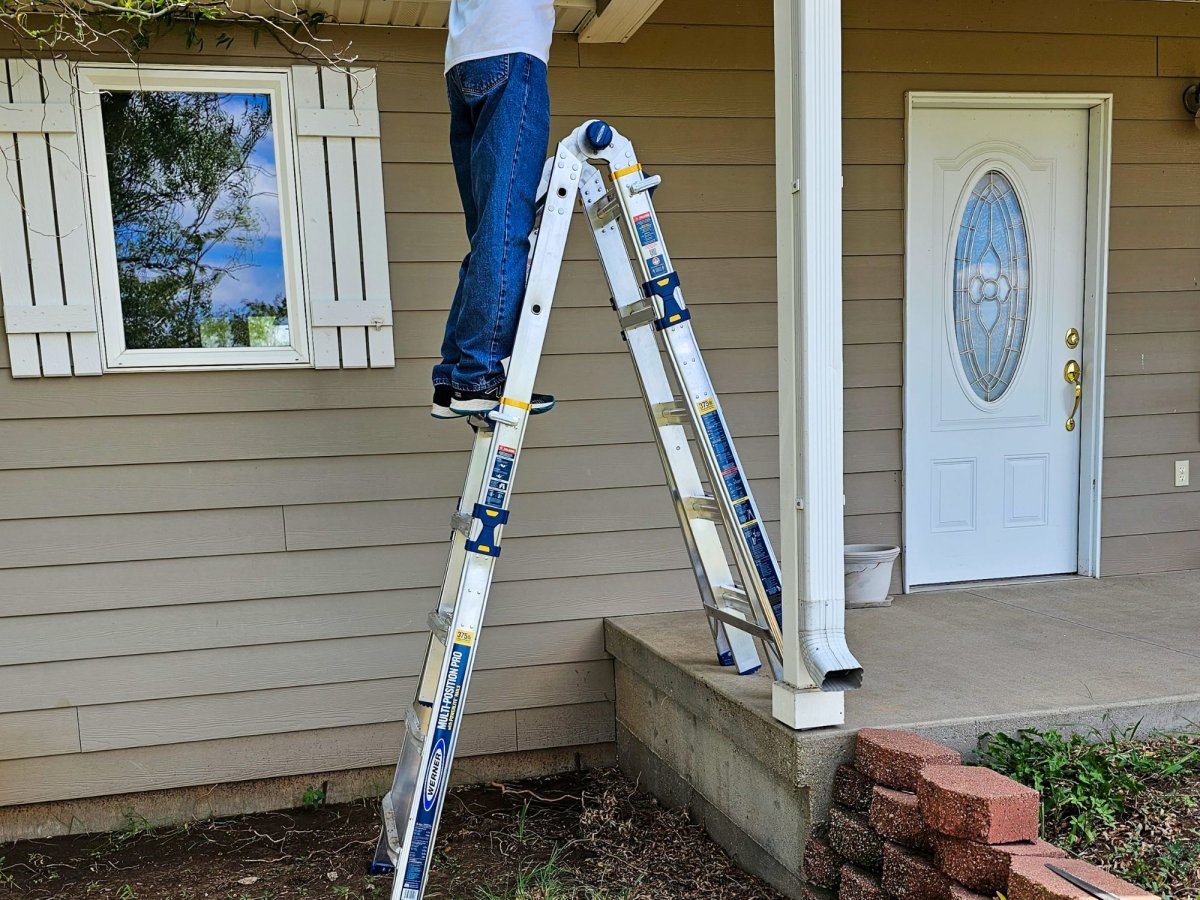
Having the right ladder in your household inventory will save you a headache or two when an odd job arises in a hard-to-reach area. Ladders are also great to have on hand if you’re planning a renovation project, such as painting or gutting an entire room.
Choosing the best ladders for our tests involved researching more than three dozen models, focusing strongly on trusted brands such as Gorilla, Werner, and Little Giant. We also considered customer satisfaction and selected ladders in various categories: multi-position, extension, telescoping, and step ladders. Additionally, we factored in budget and intended use.
In the testing phase, we analyzed build quality, ease of use, and stability in real-world situations. We adjusted the ladders, climbed on them, bounced around a bit, and checked out their safety features. We used a rubric to score each ladder, ranking them by performance—the better a ladder performed on a test, the higher its score. After testing, we averaged the scores to determine each ladder’s placement and recommended applications.
What to Consider When Choosing a Ladder
It’s essential to take into account factors such as material construction, height, weight capacity, and any additional features. These elements collectively contribute to ladder safety, overall efficiency, and suitability for specific tasks.
Material
Wood, fiberglass, and aluminum are the three most common materials used in both traditional and fire escape ladders. Keep the following material characteristics in mind while shopping:
- Aluminum is the lightest option and least likely to corrode. This metal is among the most effective conductors of electricity; as such, aluminum ladders are not recommended for electrical work or use near electrical lines.
- Fiberglass models are heavier than aluminum ladders but more robust. As a nonconductive material, fiberglass ladders will serve users well in electrical and nonelectrical applications. They may cost more than aluminum and wood models.
- Wood ladders are often the most economical, but they’re heavier and may not last as long. Wood rots if left outside. These ladders are best suited for work indoors.
Reach Height
If you must strain your arms, stand on tiptoe, or exceed the tallest climbable step to reach the desired height, that means that the ladder is too short. Potential consequences range from minor discomfort to dangerous slips and falls. For this reason, it’s important to consider reach height, or the highest point a person can safely access while standing on the ladder. Reach height can be more or less than the height of a ladder and varies by type:
- Step, platform, and A-frame: ladder height, plus 4 feet
- Multi-position: ladder height, plus 1 foot
- Extension and telescoping: ladder height, minus 1 foot
For instance, most adults can reach an 8-foot ceiling using a 4-foot step, platform, or A-frame ladder. To access first-floor gutters (usually 11 feet high), a ladder between 7 and 12 feet is typically sufficient. Those who prefer self-supporting ladders can opt for a 7-foot platform, A-frame, or a 10-foot multi-position model. Alternatively, a 12-foot extension or telescoping ladder can be positioned against a building.
Load Capacity
The load capacity is the maximum weight a ladder will hold. Ladders fall into five categories based on how much weight they support:
- Type IAA ladders hold up to 375 pounds
- Type IA ladders hold up to 300 pounds
- Type I ladders hold up to 250 pounds
- Type II ladders hold up to 225 pounds
- Type III ladders hold up to 200 pounds
When determining the load capacity needed for a project, factor in the user’s weight, plus the weight of the tools and supplies that need to be carried up or stored on the ladder (if it has a built-in tray or shelf).
Accessories
Many modern ladders include built-in accessories that boost storage capacity, reduce strain, and protect nearby surfaces. Popular add-ons include:
- A pail shelf, usually extending from the rear rail level with one of the steps to hold paint buckets or utensils.
- Ladder caps that slide over the rail ends to prevent damage to whatever surface the ladder is propped against.
- Podiums, or large platforms that take the place of one or more steps. A podium ladder provides extra foot room during long or intensive jobs and is sometimes called a platform ladder.
Types of Ladders
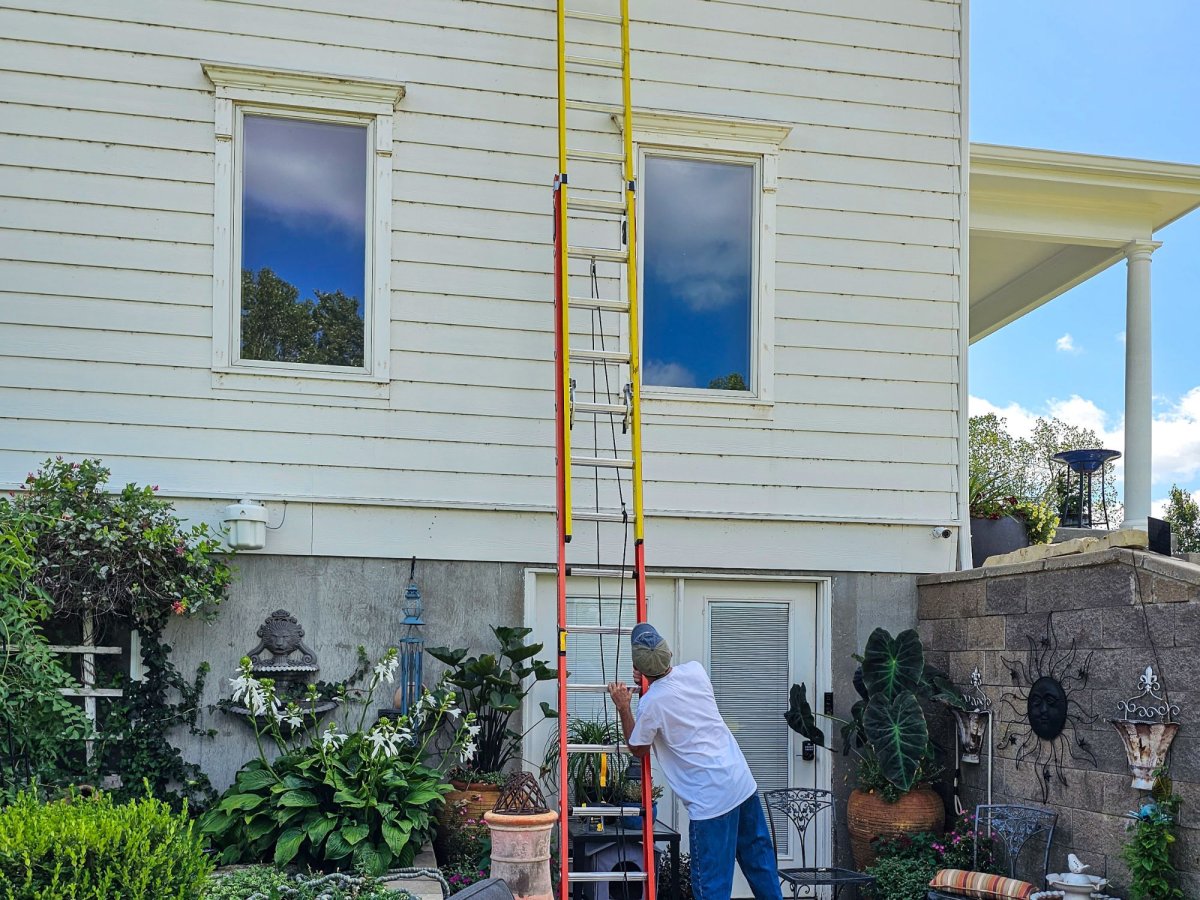
Ladders come in four main designs, all portable but each suited to different household or jobsite projects, indoors or out, at low or high heights. Read on for some of the most common ladder styles.
Step Ladder
The smallest type of self-supporting ladder, a step ladder stands independently on a level, nonslip surface. It typically measures no more than 4 to 6 feet tall from the base to the top cap (the uppermost platform).
These foldable, nonadjustable ladders aid in one-person indoor tasks where only a little boost is needed. Step ladders are useful for changing light bulbs, reaching top shelves, and cleaning hard-to-reach areas. On the smallest models, you can climb every step, including the top cap.
A-Frame
A-frame ladders are nonadjustable, self-supporting ladders that measure 4 to 20 feet tall when standing on a level, nonslip surface. This height might make an A-frame or platform ladder the best type for home use, especially as an attic ladder.
These versatile ladders are handy for ceiling-fixture installation, first-floor window replacement, and gutter cleaning on single-story homes. A hinged design makes them easy to use as an attic ladder and simple to collapse and store. A-frame models come in two varieties: single side or twin step.
- Single-side A-frame ladders have a single climbable rail with flat steps that successively narrow in width as they get higher. A rear rail, while present, is typically nonclimbable. The top cap and the topmost step of the front rail likewise can’t support a person. Typically these ladders are used outdoors or as an attic ladder.
- Twin-step A-frame ladders have steps on both the front and rear rails. Depending on the model, these sturdy ladders can support one or two people at a time.
Extension
Extension ladders require a structure such as a wall to prop up against. They should rest at an angle of around 75.5 degrees from the supporting structure for optimal stability.
These ladders measure up to 14 feet when collapsed, and one or more sections extend to increase the length up to 72 feet. Extension ladders rise to tasks such as painting siding, hanging Christmas lights, and cleaning second-story gutters. These ladders contain square or D-shaped rungs considerably narrower than those found on step or A-frame ladders. For this reason, it’s important to wear shoes with good traction when climbing an extension ladder.
Telescoping
Unlike extension ladders, telescoping ladders are more versatile. You can extend the length of the ladder by the foot and lock it into position at the desired height. A telescoping ladder usually ranges from about 8 to 12 feet high when fully extended.
Made of either fiberglass or aluminum, telescoping ladders weigh between 16 and 42 pounds. When folded, the small footprint and lightweight design add up to a portable ladder that fits in the trunk of a vehicle or a small closet. When leaning these straight ladders against the wall, use the 1-to-4 rule for safety: For every 4 feet of height, move the base of the ladder 1 foot from the wall.
Multi-position
The best mult-iposition ladder (or multiuse ladder) includes hinges that lock in multiple configurations. These models transform into self-supporting and wall-supported configurations, including A-frames, extension ladders, scaffolds, and more. Depending on the design, multi-position ladders can reach up to 30 feet.
As the name implies, multi-position ladders help tackle a variety of jobs around the house that may require various ladder types, or a single job that would benefit from more than one ladder type. For example, painting a wall along a staircase might require the ladder to lean against the wall at the base of the staircase and then fold into an A-frame position on the steps.
Be sure to unlock/lock and reposition the hinges only from the ground level; it’s imperative not to attempt these adjustments while climbing the ladder.
Tips for Using a Ladder
Like any other tool, a ladder should be treated as a potential hazard. Incorrect use or selecting the wrong ladder for a task can lead to accidents. Even a well-constructed ladder comes with risks if it’s not positioned correctly, climbed responsibly, or chosen thoughtfully.
Begin by selecting a ladder type that matches the task’s requirements and offers adequate height, preventing overstretching. Verify the weight limit or load capacity considering the user’s weight and the weight of any tools or supplies they’re carrying.
When positioning the ladder against a structure, ensure it’s set at the recommended angle, especially if it’s not self-supporting. All ladder legs should be securely placed on stable ground. Maintaining three points of contact at all times is crucial—this involves having two feet and one hand on the rungs.
Extending and collapsing ladders, such as extendable and telescoping models, should be done with care to prevent hand or finger injuries. Wear footwear with excellent traction, preferably sturdy work boots or shoes, to ensure stability. Avoid using the ladder in adverse weather conditions to prevent accidents.
Here are a few more essential points to remember to avoid dangerous and costly mistakes with a ladder:
- Climbing technique: Never ascend with your back to the ladder or pass beneath it. Always face the ladder while climbing.
- Avoid side rails for support: Refrain from using the ladder’s side rails to pull yourself up. Stepping on the top cap or highest rail is also discouraged.
- Tool placement: Don’t leave tools on ladder steps; they can create tripping hazards and instability.
- Secure the ladder: Always lock the ladder in place while using it to ensure stability and prevent unexpected movement.
FAQs
For more information about the best ladder, check out these answers to some of the most common questions. If additional concerns arise, contact the manufacturer.information about the best ladder, check out these answers to some of the most common questions. If additional concerns arise, contact the manufacturer.
Little Giant Ladder Systems, Gorilla, and Werner are trustworthy brands that produce some of the safest ladder options.
Aluminum is the lightest option and least likely to corrode, but this metal is among the most effective conductors of electricity. That means you shouldn’t use metal ladders for electrical work or near electrical power lines.
Fiberglass, while heavier than aluminum, is stronger and more versatile. It’s nonconductive, so fiberglass ladders can be used for electrical and nonelectrical applications.
An adult standing can safely reach about 4 feet higher than a step ladder’s height. If using a multi-position ladder, reaching 1 foot higher than the ladder’s height is considered safe. For an extension ladder, 1 foot below the ladder’s height is regarded as the maximum reach. For safety, do not work above the manufacturer’s recommended reach on any ladder.
An appropriately sized ladder has enough height that you don’t have to reach too much or stand on your toes. Reach height (the highest point a person can safely access while standing on the ladder) can be more or less than the height of a ladder and varies by type.
Extension ladders: For extension ladders, it’s recommended that the ladder be 7 to 10 feet longer than the highest point it will support or contact. This point can be the wall or roof line. This additional length accounts for proper setup, overlapping of ladder sections, height restrictions of the highest standing level, and, where applicable, the extension of the ladder above the roof line. For stability, the highest standing level is typically located four rungs down from the top.
Step ladders: On step ladders, the highest permitted standing level is typically two steps down from the top. This rule is essential for maintaining balance and preventing falls. Additionally, it’s important to note that a person’s maximum safe reaching height is approximately 4 feet higher than the ladder’s height. For instance, a standard individual can safely reach an 8-foot ceiling using a 4-foot ladder.
One of the best multiposition models is the Little Giant Ladders Systems Velocity ladder, with extensive reach and adjustable A-frame, extension, trestle and plank, staircase, and 90-degree configurations.
Meet the Tester
Glenda Taylor is a product tester and writer specializing in the construction, remodeling, and real estate industries. As co-owner of a general contracting company, she tests a wide range of power tools as well as other home improvement, household, and lawn-and-garden products.
Mark Wolfe is a writer and product tester with a background in plant care and landscaping. For more than 20 years he mowed, edged, planted, pruned, cultivated, irrigated, and renovated beautiful landscapes. Now he tests and writes reviews about the latest outdoor power equipment, hand tools, lawn care products, and other outdoor-living goods.
Additional research provided by Manasa Reddigari and Tiffany Lewis.

